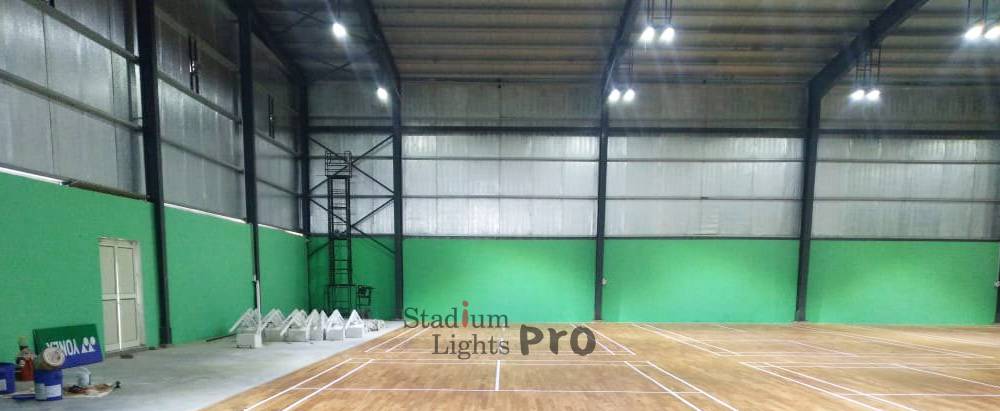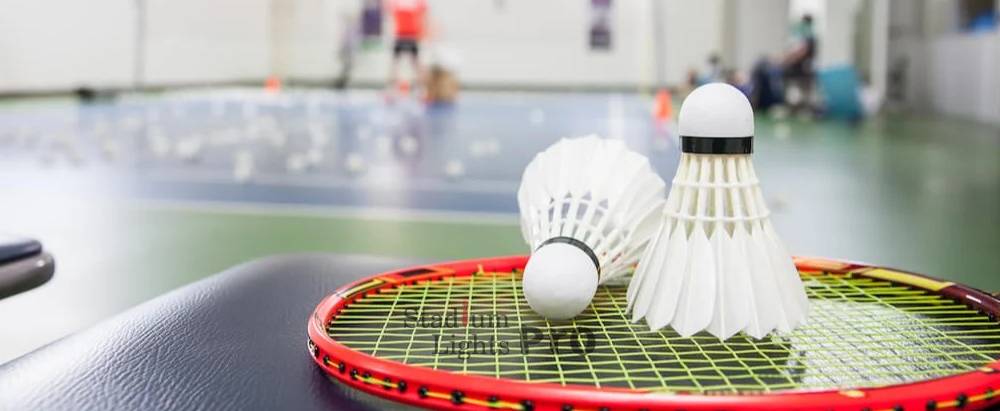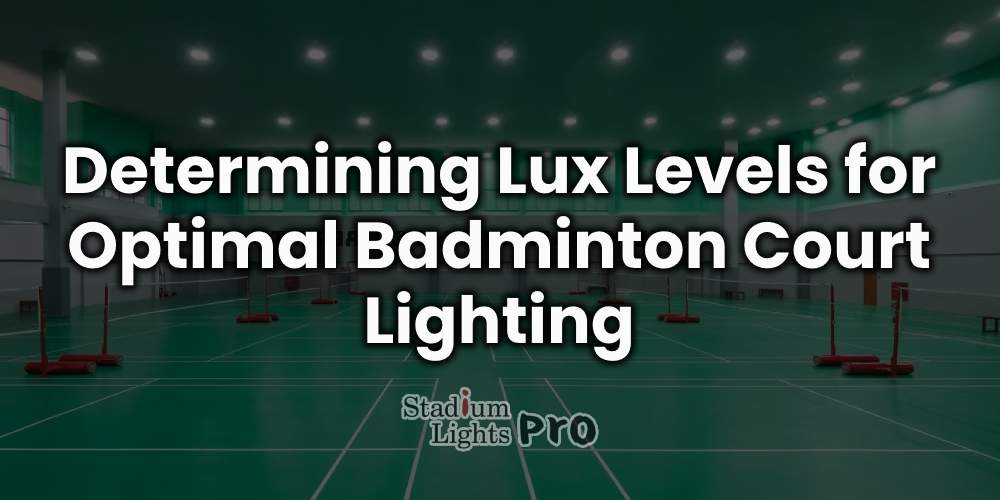Table of Contents
ToggleUnderstanding Lux Requirements for Badminton Courts
Lux levels are pivotal in sports lighting, influencing players’ performance, safety, and overall experience. For badminton, the International Badminton Federation (IBF) specifies certain lux levels to ensure a fair and enjoyable game. These standards vary for indoor and outdoor courts due to differing environmental conditions.

Indoor Court
Indoor badminton courts require a higher level of illuminance compared to their outdoor counterparts to ensure optimal visibility and performance. The recommended lux level for indoor badminton courts is between 300 and 500 lux. This range is crucial for several reasons. First and foremost, the higher lux level provides uniform lighting that reduces shadows and glare. In a fast-paced sport like badminton, where precision and quick reflexes are essential, any uneven lighting can severely impact a player’s ability to see the shuttlecock and respond effectively.
Uniform lighting across the entire court is necessary to avoid discrepancies that might give one player an unfair advantage or hinder their performance. A lux level of 300 to 500 ensures that every part of the court is well-lit, from the baseline to the net, allowing players to move and react without visual obstruction. Furthermore, this level of lighting is not just for the benefit of the players but also enhances the experience for spectators. Clear and bright lighting improves visibility for those watching the match, whether from the stands or through live broadcasts.
To achieve the optimal lux levels for indoor badminton courts, the choice of lighting fixtures is paramount. LED lights have become a preferred option in indoor sports facilities due to their superior performance and efficiency. LEDs offer several advantages over traditional lighting systems such as fluorescent or halogen lights. They produce a bright, consistent light that helps maintain the high illuminance levels required for indoor badminton. Unlike conventional lighting, LEDs generate minimal heat, which is important in maintaining a comfortable environment within the sports facility. Excessive heat from lighting can affect both the players and the equipment, and can also contribute to increased cooling costs.
Besides, LEDs have a longer operational lifespan compared to traditional lighting options. This longevity reduces the frequency and cost of replacements, making them a cost-effective choice for sports facilities. Their lower energy consumption further enhances their appeal, as they contribute to reduced utility bills and lower environmental impact. LEDs are also highly adaptable, with many models offering dimming capabilities and color temperature adjustments to meet specific lighting needs.
Outdoor Court
Outdoor badminton courts present unique challenges that differ from those of indoor courts. The primary factors affecting outdoor court lighting include natural light variations, weather conditions, and environmental factors such as wind and precipitation. These challenges necessitate a different approach to lighting design and installation.
For outdoor badminton courts, the recommended lux level ranges from 200 to 300 lux. Although this range is lower than that required for indoor courts, it is still adequate to provide clear visibility and ensure fair play. The slightly lower lux level accounts for the influence of ambient natural light and the fact that outdoor courts are exposed to variable lighting conditions throughout the day and across different seasons.
One of the key advantages of using LED lighting in outdoor settings is their ability to handle diverse environmental conditions. Modern LED fixtures are designed to be durable and weather-resistant. They can withstand harsh conditions such as rain, snow, and strong winds without compromising their performance. This durability is essential for maintaining consistent lighting quality on outdoor courts, where fixtures are exposed to the elements and may experience more wear and tear compared to indoor setups.
Another significant benefit of LED lighting for outdoor badminton courts is their wide beam spread. LEDs can be configured to provide extensive coverage, ensuring that the light is evenly distributed across the entire court. This wide beam helps to minimize shadows and dark spots, providing uniform illumination that supports fair play and enhances the playing experience. Additionally, LED lights can be adjusted to accommodate varying ambient light conditions. This adaptability is particularly useful for outdoor courts, where natural light levels change throughout the day and across different seasons.
LED lighting also offers the advantage of energy efficiency. The ability to fine-tune the lighting levels according to the time of day and specific needs of the court can lead to significant energy savings. For example, during dusk or overcast conditions, the lighting can be adjusted to compensate for the reduction in natural light, ensuring that the court remains adequately illuminated without excessive energy consumption.

Achieving Optimal Lux Levels
Selecting the Right Fixtures
Selecting the appropriate lighting fixtures is fundamental to achieving the desired lux levels on a badminton court. The choice of fixtures directly impacts the quality and effectiveness of the illumination, influencing both player performance and the overall viewing experience.
For both indoor and outdoor badminton courts, high-quality LED floodlights are highly recommended. These fixtures are known for their ability to provide bright, consistent illumination while minimizing heat output and energy consumption. The effectiveness of LED floodlights in sports lighting comes from their high lumen output, which translates into better visibility and more uniform lighting across the court.
Indoor Courts
In indoor badminton courts, the placement and mounting of lighting fixtures are critical to achieving even illumination and avoiding visual distractions such as shadows and glare. Typically, LED floodlights should be mounted at a height of 6 to 8 meters. This height range is chosen based on the size of the court and the lumen output of the fixtures. Higher mounting may be required for larger courts or fixtures with lower lumen outputs to ensure adequate coverage.
The angle at which fixtures are mounted also plays a significant role. Fixtures should be angled to distribute light uniformly across the court. Proper angling helps to minimize shadows and ensure that all areas of the court, from the baseline to the net, receive consistent light. In indoor settings, where space is confined, careful planning is needed to ensure that the fixtures are positioned to avoid direct glare into players’ eyes, which can affect their performance and comfort.
Outdoor Courts
For outdoor badminton courts, the mounting of LED floodlights is generally done on tall poles. This approach ensures that the light reaches the entire playing area effectively. The height of these poles is crucial, as it needs to be sufficient to cover the court comprehensively without creating dark spots or uneven lighting. Typically, outdoor poles range from 8 to 12 meters in height, depending on the court size and the light distribution characteristics of the fixtures.
The placement of the poles must be carefully calculated to prevent shadows and ensure uniform lighting across the court. In outdoor settings, environmental factors such as wind and rain also influence the choice of fixtures. LED floodlights used for outdoor courts should be designed to withstand these elements, featuring weatherproof and durable housings that ensure long-term reliability.
Light Distribution and Uniformity
Uniform light distribution is essential in sports lighting, particularly for badminton, where fast movements and precise actions are common. Uneven lighting can lead to shadows and glare, which can hinder players’ ability to see the shuttlecock clearly and react swiftly.
To achieve uniform lighting, it is important to use fixtures that provide a wide and consistent beam spread. High-quality LED floodlights are designed to deliver broad, even illumination, which is crucial for minimizing dark spots and ensuring that every part of the court is well-lit. Proper spacing and alignment of fixtures are necessary to avoid areas of uneven lighting.
For detailed planning, lighting design software can be an invaluable tool. These software programs simulate various lighting scenarios, allowing designers to experiment with different fixture placements and configurations to optimize light distribution. By inputting factors such as fixture type, height, and spacing into the software, designers can visualize and adjust the lighting layout to meet the required lux levels effectively. Professional lighting designers frequently use these tools to create precise and efficient lighting schemes for sports facilities, ensuring that the lighting is both functional and aesthetically pleasing.
Dimming and Control Systems
Indoor Courts
For indoor badminton courts, adjustable dimming systems are particularly useful. These systems allow for fine-tuning of light levels depending on the activity taking place. During training sessions, where intense and focused lighting might be required, dimming systems can adjust the illumination to provide the right intensity. Conversely, during competitive matches, full lighting can be activated to ensure optimal visibility. This flexibility is crucial in maintaining the ideal lighting conditions for various scenarios.
Outdoor Courts
In outdoor settings, lighting control systems help manage energy consumption and adapt to changing ambient light conditions. For instance, lighting systems can be equipped with sensors that adjust the brightness based on the level of natural light. This ensures that the court remains well-lit without excessive energy use, adapting to different times of day and weather conditions.
Smart lighting controls, including motion sensors and timers, further enhance the efficiency of outdoor lighting systems. Motion sensors can activate lights only when players are present on the court, reducing unnecessary energy consumption. Timers can be programmed to turn lights on and off at specific times, ensuring that they are used only when needed. These controls not only contribute to cost savings but also improve the overall lighting experience by maintaining appropriate illumination at all times.
Benefits of LED Lighting in Badminton Courts
Energy Efficiency and Cost Savings
LED lights stand out for their remarkable energy efficiency, making them an excellent choice for badminton court lighting. Unlike traditional lighting options such as incandescent or fluorescent bulbs, LEDs convert a higher percentage of electrical energy into visible light rather than heat. This superior efficiency is measured by lumens per watt, a metric that quantifies how much light is produced for each unit of electrical power consumed. LEDs generally offer significantly higher lumens per watt compared to traditional bulbs, resulting in reduced energy consumption.
The direct benefit of this efficiency is a notable decrease in energy bills. By consuming less power to produce the same amount of light, LED lighting systems can lead to substantial savings over time. This is particularly beneficial in large-scale sports facilities or multi-court complexes, where lighting can account for a significant portion of the operational costs. In addition to cost savings on electricity, the reduced energy consumption contributes to a lower carbon footprint, making LEDs an environmentally friendly choice.
Another significant advantage of LEDs is their long operational lifespan. LEDs typically last between 25,000 to 50,000 hours, far surpassing the lifespan of traditional lighting options. This extended lifespan reduces the frequency of replacements and the associated labor and material costs. Fewer replacements mean less maintenance time and fewer disruptions to the court’s use, contributing to overall cost savings and operational efficiency. The durability of LEDs also means they are less prone to breakage, further reducing the costs associated with fixture replacement and maintenance.
Improved Light Quality
The quality of light provided by LEDs is another critical factor that enhances their suitability for badminton courts. LED lights are known for their excellent color rendering, which refers to the ability of a light source to reveal the true colors of objects as compared to natural light. High color rendering index (CRI) values are crucial in sports settings, where accurate color perception is necessary for optimal performance.
For badminton, where players need to track a fast-moving shuttlecock, the bright, consistent light produced by LEDs helps improve visibility and minimize glare and shadows. Traditional lighting systems often suffer from uneven light distribution and inconsistent brightness, which can create areas of shadow and reduce the overall clarity of the playing area. LEDs, with their even beam spread and high luminance, ensure that the entire court is uniformly lit, enhancing players’ ability to see and react swiftly to the shuttlecock.
The consistent and high-quality illumination provided by LEDs also contributes to a better overall playing experience. Players can perform at their best when they can clearly see the shuttlecock and judge distances accurately. This improved visibility helps maintain high standards of performance and reduces the risk of errors caused by inadequate lighting.
Durability and Reliability
LED fixtures are engineered to be highly durable, which is particularly advantageous for both indoor and outdoor badminton courts. Their robust construction makes them resistant to physical impacts, vibrations, and other potential sources of damage. This durability ensures that LEDs can withstand the rigorous conditions often encountered in sports environments, where fixtures are subject to frequent use and occasional impacts.
For outdoor badminton courts, the durability of LEDs extends to their ability to resist harsh weather conditions. Modern LED fixtures are designed with weatherproof housings that protect the internal components from moisture, dust, and extreme temperatures. This weather resistance is crucial for maintaining reliable performance throughout the year, regardless of seasonal changes or adverse weather conditions. Rain, snow, and temperature fluctuations are common challenges for outdoor lighting, and LEDs’ resistance to these elements ensures that they provide consistent illumination without frequent maintenance or replacement.
In addition to weather resistance, LEDs are designed to operate effectively in a wide range of temperatures. Unlike traditional bulbs that may struggle with performance issues in extreme conditions, LEDs maintain their brightness and efficiency in both cold and hot environments. This reliability ensures that badminton courts, whether indoors or outdoors, are always properly lit, supporting both player performance and spectator experience.
Conclusion
Indoor courts require higher lux levels (300 to 500 lux) to ensure uniform lighting, reduce shadows, and enhance visibility, benefiting both players and spectators. Outdoor courts, on the other hand, need a lower range of 200 to 300 lux due to variable natural light conditions but still demand high-quality, weather-resistant LED fixtures to maintain consistent illumination. LEDs not only meet these requirements with superior efficiency and durability but also offer significant cost savings and improved light quality, making them an ideal choice for both indoor and outdoor badminton courts.

